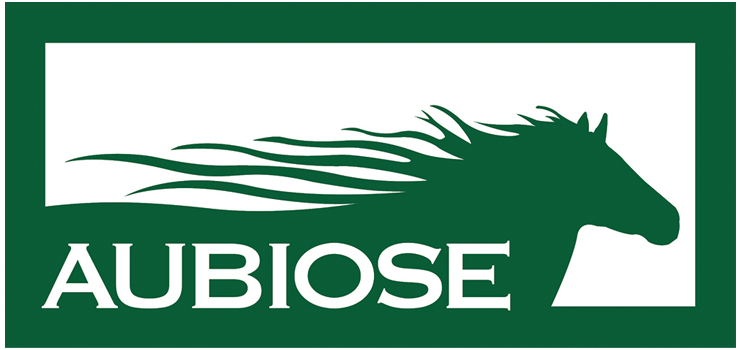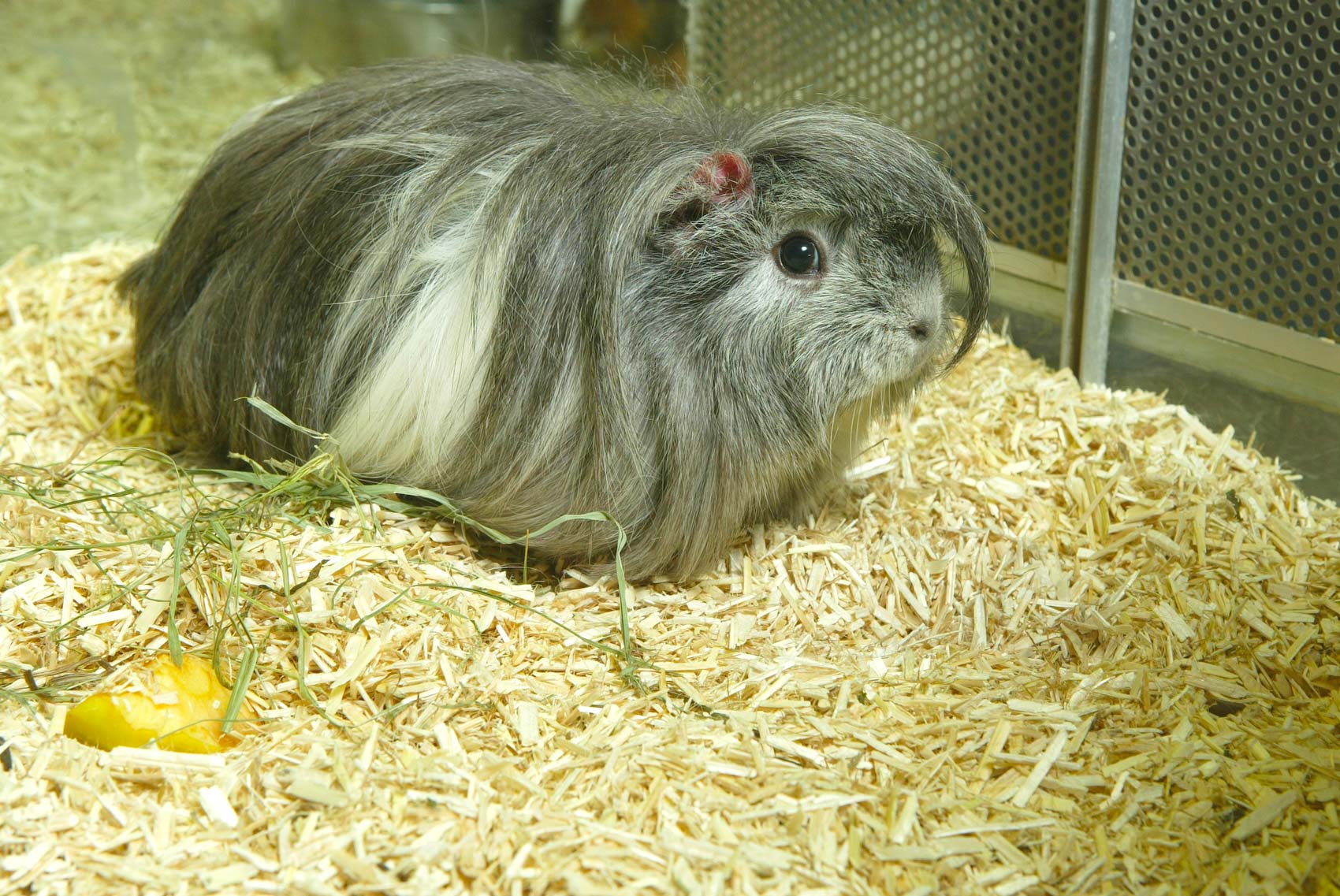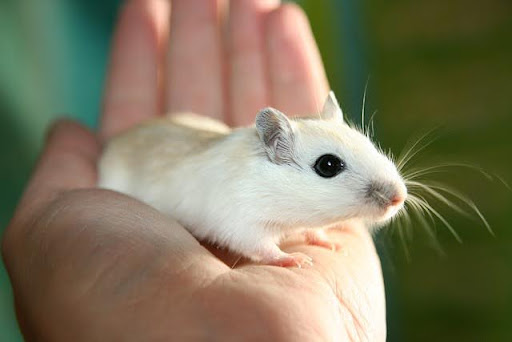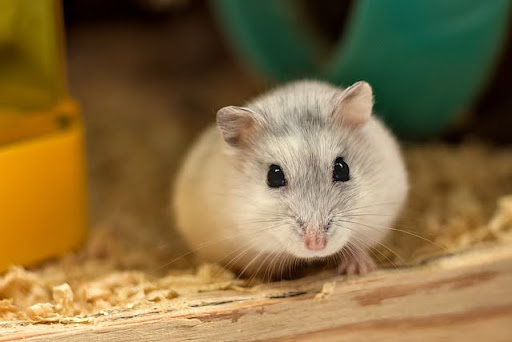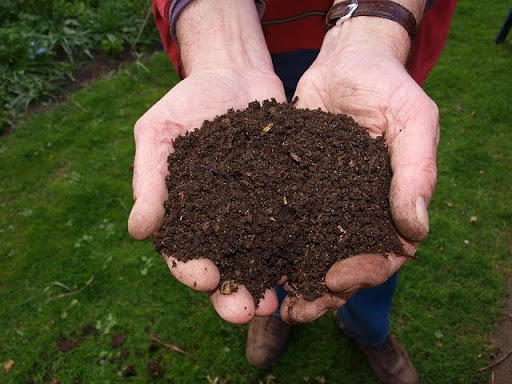Animal bedding is an essential part of the lives of many pet and livestock owners. Whether you share your daily life with a cat, dog, hamster, chickens, goats, or rabbits, choosing the perfect bedding will save you some troubles later on.
In this guide, we will cover the following points:
- Why take the time to compare before buying your animal’s bedding?
- Which pets and livestock need bedding daily?
- Pets
- Cats
- Rodents
- Reptiles
- Livestock
- Chickens
- Goats
- Rabbits
- Pets
- Choose bedding that doesn’t stick to your animals’ paws
- The different types of animal bedding available
- Which animal bedding is the most absorbent?
- Preserving your facilities
- How to prevent your animal’s bedding from smelling?
- How often to change your animal’s bedding?
- Horses
- Chickens and goats
- Rodents (rabbits, guinea pigs, hamsters, etc.)
- Floor, structure, and location: key points to consider to extend the life of your animal’s bedding
- The floor: an essential component of your animal’s habitat
- Favor spacious and comfortable arrangements
- Determine the ideal location for your animal’s bedding
- Summary of the guide
Why take the time to compare before buying your animal’s bedding?
The question seems obvious for many everyday products. But consumable solutions can be the subject of less thorough analysis. Bedding is one of those purchases that we do not always think about long enough before taking action.
Rushing the choice of bedding to protect the floor of your chicken coops, cages, and barns will not help you. A hasty choice might instead waste your time in the long run and force you to search again within a few weeks.
Why?
Because the bedding you chose will ultimately not meet your animals’ and your criteria:
- Ammonia odor rising
- Poor absorption of urine and ambient condensation
- Notable discomfort developing in your animals
- Cracks appearing on the paws or respiratory issues
- Shavings scattered around your home
The reasons prompting an animal owner to reconsider their bedding choices are multiple. Knowing these reasons in advance will help you avoid a bad purchase and save time and budget!
Which pets and livestock need bedding daily?
Cats
Cats are perhaps the first animals that come to mind when talking about bedding. These animals, many of which share our homes, are known for their natural instinct to find a cozy, hidden spot for their needs.
What better for that than a litter box entirely dedicated to their business?
For cat owners, choosing the right bedding prevents their feline friends from developing unclean habits. Popular options include:
- Clumping clay litter
- Plant-based litter
- Silica litter
Among plant-based litters, hemp bedding emerges as an attractive alternative due to its absorbent properties and reduced ecological impact.

Rodents
Hamsters, rabbits, guinea pigs, and other small rodents like gerbils also need bedding to keep their environment clean, dry, and healthy. Comfortable bedding will also allow them to build nests and tunnels necessary for their well-being.

Reptiles
Beginners might think that turtles, snakes, and other reptiles like bearded dragons or geckos do not need bedding. In reality, the bottom of their terrarium should be covered with a substrate that varies by species. Some animals will need coarse gravel that does not stick to their eyes or tongue. Others will prefer wood bark, like oak or ash, or fine poplar shavings (called litaspen).
Chickens
To keep a comfortable chicken coop, many chicken owners opt for straw bedding. Wood shavings or hemp bedding will also do perfectly, as they retain more moisture.

Goats
For goats, installing bedding provides good thermal comfort and absorbs waste, especially during birthing periods.
Rabbits
Rabbits appreciate soft, comfortable bedding that allows them to dig and hide, behaviors essential to their psychological well-being.

Choose bedding that doesn’t stick to your animals’ paws
Bedding can stick to your animals’ paws in some cases. This regularly happens with clumping mineral litter, which is designed to cling to wet areas. Thus, it is not surprising to see litter sticking around their paws if they are wet (rainy weather, frequent licking of fur, etc.).
Over time, the accumulation of litter on their limbs can injure your animal, in addition to scattering around your home if your pet is a companion animal or a dedicated space if it is part of livestock.
Plant-based bedding, like wood shavings, can also stick to paws. Wood shavings have this problem but have the advantage of not physically damaging the animal’s skin.
Some litters stick less to paws than others. This is the case with hemp bedding, which, besides being dusted, has a very high absorbent capacity allowing longer intervals between renewals.
The different types of animal bedding available
When it comes to choosing the best bedding for your pets, the selection can quickly become daunting. Here are the two main types of bedding available on the market. We have detailed their main characteristics for you:
Plant-based bedding
Made from natural materials such as wood, corn cobs, straw, hemp, recycled paper… This bedding is appreciated for its ecological nature. It is biodegradable and compostable.
Plant-based bedding comes in different forms: pellets, shavings, sawdust… Most plant-based beddings (except for straw and paper) are absorbent and offer better odor control than mineral bedding.
In case of surrounding dispersion, it can decompose in an outdoor soil without requiring intervention (except for straw which takes time to degrade). If litter scatters in your home, know that it is easily removable and does not hurt the feet or paws of your animals (unlike mineral gravel litter, for example).
It is sometimes more difficult to capture due to its volatility. Some plant-based litters, except for Aubiose hemp bedding (dusted to over 99%!) and generally very high-quality flax bedding, can cause allergies in your animals.
Mineral bedding
This bedding is very popular among cat owners. The most appreciated form is undoubtedly clumping mineral litter due to its ability to form solid clumps when wet. This feature makes cleaning easier and reduces the volume of litter to add when removing the hardened blocks of litter.
It is quite effective in controlling odors. However, it can be dusty. Its renewal requires careful handling to avoid dust dispersion. Storage may not be very convenient; this litter is packaged in bags or cartons. The former do not stack, the latter are sensitive to moisture… Apart from cats, it is hardly usable for other animal species. Mineral bedding offers very little versatility.
Comparison summary
The choice of bedding depends on:
- The animal species (cats will have more choices than livestock animals like chickens, rabbits, or sheep)
- Your requirements (dust emission, absorption capacity, litter format, packaging, renewal frequency, etc.)
According to our comparison, plant-based bedding accumulates more benefits than other types. If you opt for plant-based bedding for your animals, we highly recommend hemp bedding:
- Aubiose for your horses
○ Sizes available: 10kg & 20kg. - and Aubizoo for your rodent companions!
○ In compressed bags to save space, available in 1.5kg, 3kg, 7kg, or 20kg. And in loose bags, easy to use for setup, available in 30L and 100L bags.
Aubiose for your horses
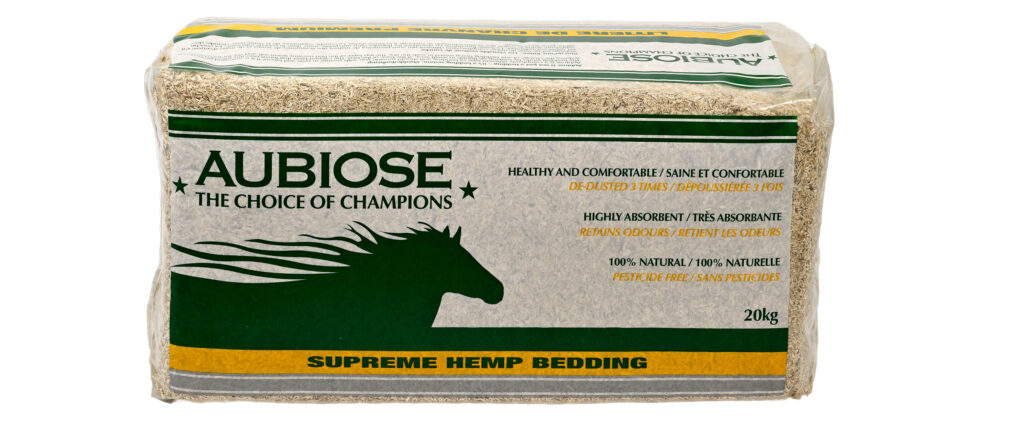
and Aubizoo for your rodent companions!
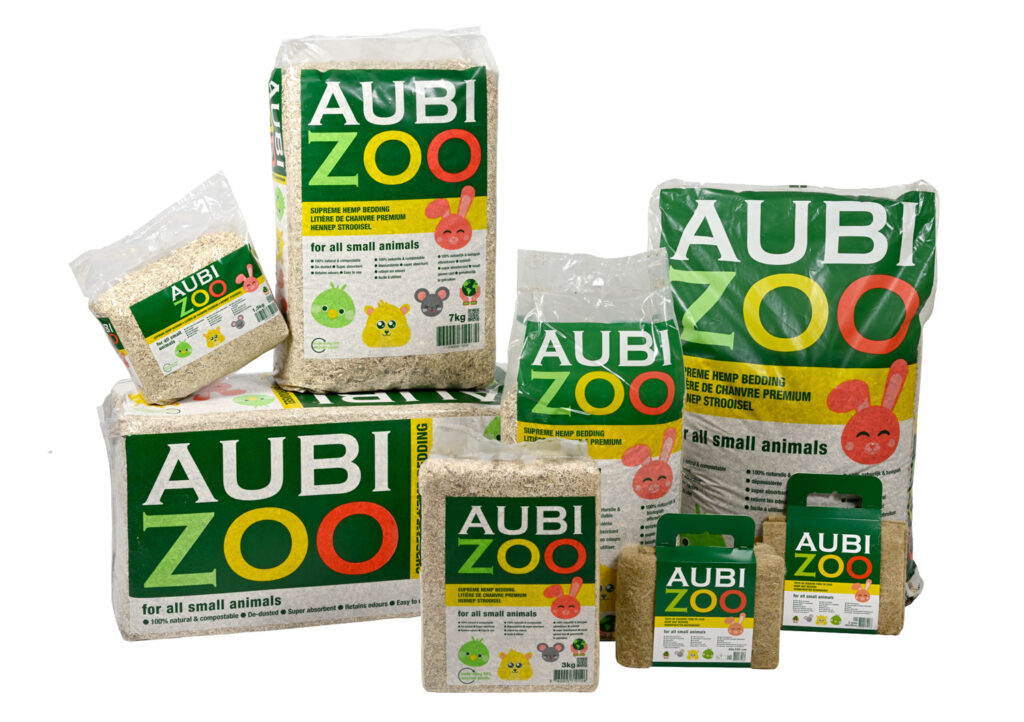
Which animal bedding is the most absorbent?
Logically, hemp is often used as bedding for domestic and livestock animals due to its high capacity to absorb odors and biological liquids. It is one of the most absorbent beddings on the market.
Preserving your facilities
Retaining animal urine helps preserve the floors of horse stalls (bedding usually resting directly on the cement slab, known to be porous).
For wooden installations, good moisture retention preserves the structure’s integrity by preventing rotting.
How to prevent your animal’s bedding from smelling?
Here are some tips to prevent your animal’s bedding from becoming malodorous. (Note that depending on the species, you will not always change the bedding in the same way or at the same frequency.)
- Clean regularly
This may seem logical. But the source of bad odors often lies in too infrequent renewal of your animal’s bedding. For all animal species: remove solid excrements daily! - Avoid excessive moisture
Bedding will start to emit an unpleasant odor if it becomes too wet. Ensure you have a sufficient and functional ventilation system to remove this moisture that tends to accumulate quickly. - Use specific cleaning products
Use disinfectant cleaning products specific to the animal species you are raising. For pet owners and bedding users, be sure to thoroughly clean and rinse litter boxes, terrariums, and other shelters. Note: Using specific products is not necessary for horses.
Good to know
Sometimes the source of bad odors is not related to the degradation of your animal’s bedding. A sudden change in odor can be a sign of a health problem in your animal that would affect the nature of its urine and feces. Consult a veterinarian if you notice significant changes in the smell of the bedding and the condition of your animals, but have not changed your cleaning protocol.
How often to change your animal’s bedding?
The frequency with which you should renew your animal’s bedding depends on several factors, including:
- The size of the animal
- The type of bedding used
- The space occupied by your animals
- And the number of individuals present in the enclosure, stall, cage, etc.
Here are general recommendations for different species:
Horses
If you use traditional bedding like straw:
- Stalls: Your horse’s stalls should be cleaned daily. Solid excrements should be removed every day.
- Complete renewal : The bedding in the stall should be completely replaced every 1 to 2 weeks, depending on the amount of urine and manure accumulated.
- Paddock: In paddocks, the bedding can be renewed

Chickens and Goats
Chicken Coop / Goat and Sheep Enclosure
- Daily Maintenance: Remove droppings and excessively wet areas daily.
- Complete Renewal: Replace bedding completely every 1 to 2 weeks.
Rodents (Rabbits, Guinea Pigs, Hamsters, etc.)
Cage:
- Daily Maintenance: These animals produce solid droppings that don’t heavily soil the bedding. However, the smell of their urine is quite strong and requires frequent removal of the bedding.
- Complete Renewal: The bedding in your rodent cages should be fully replaced at least twice a week, although this depends on the brand of bedding used. Of course, the number of animals per cage should be proportional to its size for these guidelines to be accurate.
Floor, Structure, and Location: Key Points to Consider to Extend the Life of Your Animal’s Bedding
These considerations apply whether you have a litter box for cats, cages or hutches for rodents, or chicken coops or aviaries for poultry. But regardless of the name of their habitats, they all share a common point: the daily use of bedding…
1. The Floor: An Essential Component of Your Animal’s Habitat
Bedding can be applied in any of these structures. However, the floor must be stable, clean, free from moisture, and objects that could injure your animals.
○ Whether made of plastic, concrete, or wood, the “litter box” may sometimes tend to trap odors and moisture, acting as a natural diffuser… If you have opted for a porous material or one known to diffuse captured odors, choose to bypass the problem by relying on ultra-absorbent bedding.
2. Favor Spacious and Comfortable Arrangements
There should be enough space for your animals to move freely. The structure must have a waterproof roof to prevent leaks that could accelerate the degradation of the bedding and make your livestock sick.
○ For cats, closed litter boxes are appreciated as they avoid having a bird’s eye view of the box’s contents. However, this choice should not be motivated by the containment of odors. To limit these, only opting for a litter that prevents odors will be beneficial./p>
3. Determine the Ideal Location for Your Animal’s Bedding
Your outdoor installations should be sheltered from the elements.
For indoor animals, avoid placing the litter box or cage in high-traffic areas that would hinder your animals. Exposure to direct sunlight is also prohibited and will not help dry out a litter that has low absorption power.
In case of exposure to direct sunlight, good insulation is required for the well-being of your animals. (Note that a poorly ventilated box where stifling heat reigns due to non-existent insulation will also be a perfect combination for the spread of odors in your stable).
Summary of the Guide
This comprehensive guide on animal bedding helps you better consider today the various aspects to consider when choosing the ideal bedding for your furry, feathered, or scaly companions. Various types of bedding are available on the market, and this guide aims to help you assess and understand the characteristics of the different solutions available to you.
This guide is a free resource from our blog, but there are others!
Discover our related content:
- Aubiose
- Hemp Bedding vs. Traditional Bedding
- The choice of bedding for horses is crucial…
